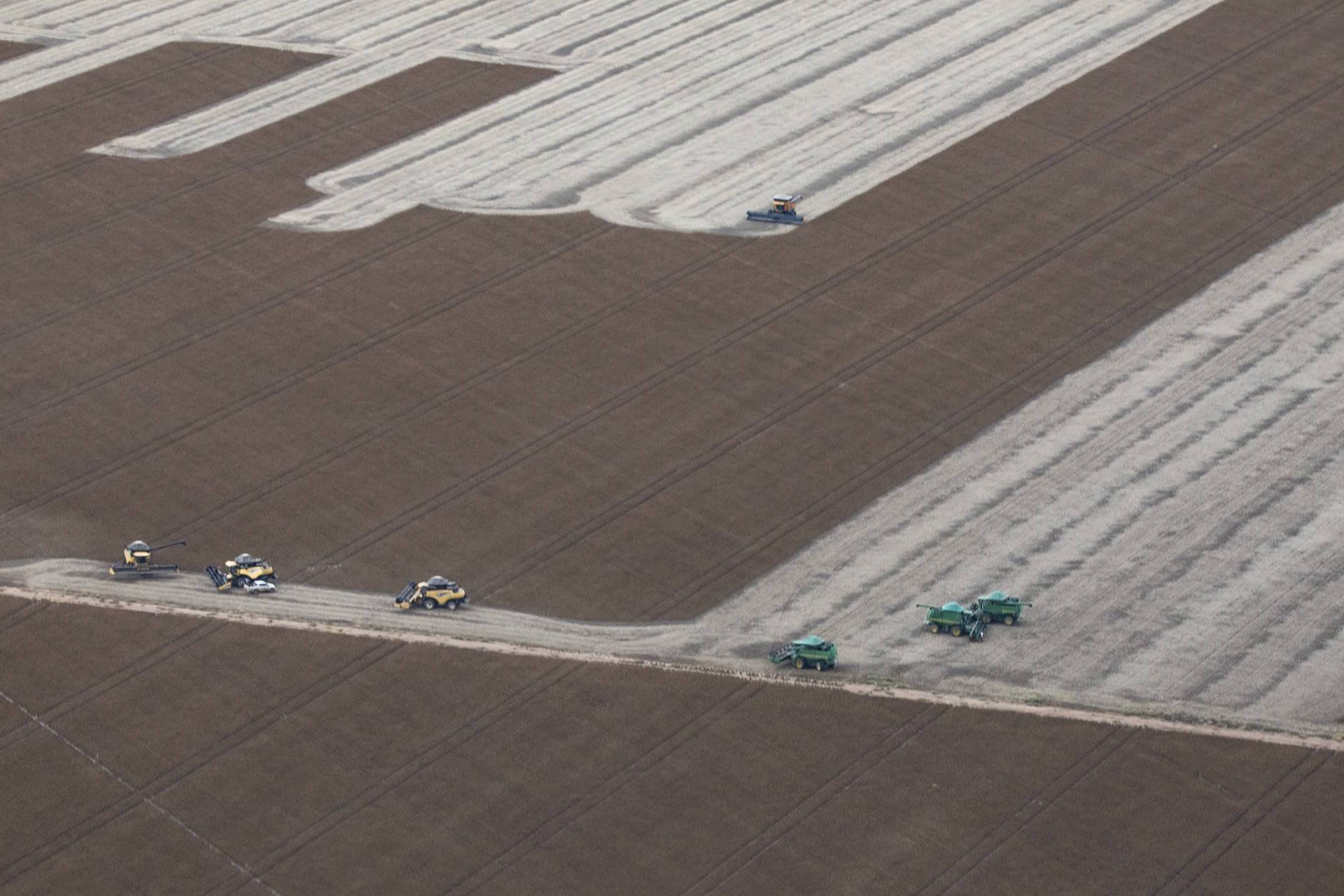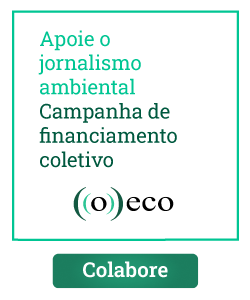Stretching across nearly 2 million square kilometers in South America, the Cerrado is one of the world’s largest tropical savannas. While small fragments reach into Bolivia and Paraguay, around 98% of it lies within Brazil, where it covers roughly a quarter of the national territory.
Large rivers such as the Tocantins, Paraná, and Xingu originate in the Cerrado, earning it the nickname “Brazil’s water tank”. However, deforestation and vast monocultures have compromised this vital role. If degradation is not halted and native vegetation is not restored, the impacts will grow even more severe, affecting even agribusiness.
Marcelo Urtado, an agronomist and certified coffee producer in Monte Carmelo, in the northwest of Minas Gerais state, says his family is already feeling the effects of these changes. Droughts have worsened over the past two decades, and since 2021 has become critical. “No one has had a good harvest anymore”, he reports.
The Três Meninas Farm – named after Urtado’s two daughters and his wife – is among the many properties affected throughout the Cerrado biome. But the consequences extend beyond the countryside. The drop in production has driven coffee prices in supermarkets up by nearly 60%.
“Many people are concerned about water shortages or rising prices, but don’t connect it to deforestation”, says Yuri Salmona, who holds a PhD in Forest Sciences and is director of the Instituto Cerrados. An investigation by Ambiental Media, supported by the NGO, sheds light on some of the culprits behind these crises.
The figures help tell the story. Since 1985 alone, the Cerrado has lost 22% of its native vegetation, while the area planted with soy has expanded nearly twentyfold – leaping from 6,200 km² to over 120,000 km² -, an area comparable to the entire Brazilian state of Amapá, or entire England.
Isabel Belloni Schmidt, PhD in Plant Ecology and professor in the Department of Ecology at the University of Brasília (UnB), explains that deforestation reduces water infiltration into the soil and plant transpiration, which leads to the drying and silting up of water sources. “It’s not unexpected, but it is frightening”, concludes.

Another part of the problem lies in weak legislation. While farms in the Amazon are required to preserve up to 80% of native vegetation, in the Cerrado that threshold drops to just 20% to 35%. This legal loophole has enabled agribusiness to take over more than half of the biome.
This explosive deforestation has reduced the average water flow in the Araguaia, Paraná, Parnaíba, São Francisco, Taquari, and Tocantins river basins by nearly one-third. According to the investigation, the water lost in a single 24-hour period would be enough to supply the entire Brazil for three and a half days.
Beyond the major rivers, smaller but equally vital ecosystems are under similar pressure. Wetland ecosystems like veredas and perennial springs are legally recognized as priority areas for conservation due to their critical role in sustaining water resources. However, the humid grasslands that host many of these systems remain largely unprotected and poorly mapped.
As a result of this neglect, these landscapes are disappearing fast. A study led by researcher Alessandra Bassani (Unicamp), published in Perspectives in Ecology and Conservation, found that between 2008 and 2020, more than 580,000 hectares of humid grasslands were lost – 61% to agricultural use. That’s nearly four times the size of São Paulo city.
The researchers point to imprecise language in Brazil’s 2012 Forest Code as a key issue. Without clear definitions of where humid grasslands begin or how they should be protected, loopholes have emerged in licensing processes. Producers and consultants often overlook these ecosystems entirely, especially in the absence of consistent oversight.

This omission weakens protection efforts, leading to the loss of vital ecological functions such as water retention, spring protection, local climate regulation, and the ecological connectivity needed to sustain biodiversity across the Cerrado.
One region where these effects are most pronounced is the São Francisco River Basin, which supplies much of the Northeast’s agricultural sector through a major water-diversion project. There, the river’s flow has been cut in half, mainly due to the expansion of irrigated soybean production in the region known as Matopiba – an agricultural frontier spanning Maranhão, Tocantins, Piauí, and Bahia states.
“In the very areas where it’s most important to protect water sources – where springs, rivers, and infiltration should be strengthened – we are deforesting and overusing groundwater”, says Yuri Salmona of Instituto Cerrados. “They’ve traded the water security of a large part of the Northeast for soybean production”.
The devastation has also disrupted the water cycle itself. In the same river basins, rainfall has decreased while evaporation has risen. On paper, precipitation has dropped by 21%, and evapotranspiration has increased by 8%. In other words, the Cerrado is quite literally drying out.
It’s worth noting that rainfall in the biome also depends on humidity from the Amazon, which continues to suffer from deforestation and forest degradation, the report’s authors emphasize. “This crisis is partly driven by climate change, but a significant share is caused by deforestation and poor water management”, Salmona stresses.

More fire, less conservation
Situated at the crossroads of nearly all other Brazilian biomes, the Cerrado spans one-quarter of the national territory and supplies water to eight of Brazil’s twelve hydrographic regions – vast areas composed of multiple river basins. Nearly all the water in both the São Francisco River and the Pantanal wetland are supplied by the Cerrado.
This water is crucial not only for humans, but for wildlife as well. As it becomes scarcer, animals are forced to travel farther in search of food and water, leaving them increasingly vulnerable to hunting and roadkill, notes Isabel Belloni Schmidt, from the University of Brasília (UnB).
“Drought reduces the quality of natural habitats and shrinks the living range of many species, which have nowhere to expand as deforestation and habitat fragmentation continue across the Cerrado”, explains the researcher.
Another consequence of water scarcity and deforestation is the drowning of wild animals in irrigation canals, a phenomenon documented not only in Brazil but in several other countries as well, as revealed by ((o))eco in the special report Unseen Slaughter.
The crisis also affects protected areas, where drought intensifies wildfires and increases the threat to biodiversity. “The intensity, size, and duration of fire risk have all grown significantly”, observes João Paulo Morita, coordinator of Integrated Fire Management at ICMBio (Brazil’s federal agency for biodiversity conservation).


The cultural and economic activities of traditional communities, as well as the lives of animals like the maned wolf (Chrysocyon brachyurus), are also under threat due to the destruction of the Cerrado. Photos: André Dib / Ambiental Media
Brazil’s fire management policy goes beyond suppression and prevention, it also incorporates prescribed burns, currently used in over 40 federally protected areas. These efforts are especially focused on protected areas with tourism activity, such as national parks, where authorities establish evacuation routes and may temporarily close areas to the public during high-risk periods.
Moreover, as João Paulo Morita explains, fire in the Cerrado cannot and should not be completely eliminated, as it plays essential ecological and social roles. The goal, he says, is to regulate and control its use. “Measures like these are groundbreaking. No other country has a policy like this”, he affirms.
Meanwhile, Indigenous and traditional communities also face growing threats to their livelihoods, cultures, and economies due to the ongoing devastation of the Cerrado. “Traditional peoples struggle to adapt to these changes”, says Rafael Gava, president of the Rede Nacional de Brigadas Voluntárias, a national volunteer firefighting network with members from across Brazil.
The network has seen surging demand as the climate crisis renders forests increasingly vulnerable to fire. “Any spark can lead to major wildfires”, warns Gava. Since over 95% of ignitions are human-caused, constant vigilance is required. “Volunteer brigades act like fire extinguishers, but they also engage in prevention, environmental education, and ecological restoration”, he explains.
Last week, the Rede met in Brasília (DF) to discuss ways to expand environmental protection and improve public policy in support of their work. “Volunteers have bills to pay too”, Gava reminds.

Halting destruction and accelerating restoration
A Brazilian classic by Zé Keti once declared: “If there’s no water, I’ll dig a well”. Though the lyrics of the samba Opinião speak of life in the hills of Rio de Janeiro city, the phrase now aptly describes the mindset of much of Brazil’s rural elite, which continues to expand groundwater use at a breakneck pace.
According to the National Water and Basic Sanitation Agency, 70% of all land irrigated with center-pivot systems in Brazil lies within the Cerrado. This irrigation technique is among the most water-intensive and continues to grow rapidly, even in the Federal District, whose waters feed into the Paraná, São Francisco, and Tocantins-Araguaia river basins.
In the same region, environmentalists and social movements have fiercely criticized a planned natural gas–fired thermoelectric plant, which would emit 4.7 million tons of CO₂ per year, destroy 32 hectares of native Cerrado, and consume 144,000 liters of water per day.
According to Isabel Belloni Schmidt of the University of Brasília (UnB), such initiatives are pushing water consumption to unsustainable levels and worsening the biome’s crisis. “They’re solving immediate problems, but all this water being used will eventually run out – somewhere, sometime”, she warns.
But the consequences are already being felt. Excessive water use and deforestation have even caused rainfall to decline in the nation’s capital. “It no longer rains in Brasília in September, and January – the month that used to bring the most rain – has seen rainfall drop by as much as 40%”, Schmidt points out.

Climate and deforestation are tightening the noose
The worsening water scarcity, driven by the destruction of the Cerrado and the climate crisis, should be raising red flags for rural producers. A recent study published in the journal Nature warns that rising global temperatures will severely reduce crop yields for staple foods such as corn, soy, wheat, rice, cassava, and sorghum.
The research analyzed more than 12,000 regions across 54 countries and concluded that the world’s most productive farming zones – the so-called “breadbaskets”- will be disproportionately affected, exacerbating food insecurity and spreading hunger, particularly in poorer nations.
In this context, curbing destruction is urgent. “There are no more arguments to justify continued deforestation”, says Yuri Salmona of Instituto Cerrados. “It’s also essential to demarcate territories for traditional communities – who preserve the Cerrado standing – and to expand conservation areas, which today cover just 9% of the biome”.
Investment is also needed in restoring native vegetation and farming techniques that sustain the Cerrado. That’s the approach adopted by Marcelo Urtado’s family at the Três Meninas Farm, in Minas Gerais state. Over five years, they’ve implemented a regenerative agriculture model, using methods such as soil cover and reinforcement of native flora. As a result, they’ve maintained productivity and bolstered the farm’s resilience to climate stress.
According to Urtado, these practices have improved the farm’s microclimate – temperature differences of up to 20°C have been recorded between shaded and unshaded areas – and more water remains available through the dry season, right up to the coffee bloom, a phase highly sensitive to temperature swings. Without these changes, the losses would be massive.
“Even if the climate doesn’t worsen or cause any new problems, we’ve already gained by increasing water availability. It’s like an insurance policy”, says Urtado, who also serves as president of the Cerrado das Águas Consortium, an organization that promotes sustainable land use practices to tackle climate change.

Deep-rooted disregard
Isabel Belloni Schmidt of the University of Brasília (UnB) is co-author of a study published in the Journal of Applied Ecology which reveals that both the media and scientific research tend to privilege forests over grasslands and savannas, including ecosystems like the Cerrado.
“People are not sensitized to any type of vegetation that isn’t a forest”, says the scientist. “And when that happens, you end up ignoring the water and other ecosystem services these landscapes provide, as if they could be deforested at will”.
According to Yuri Salmona of Instituto Cerrados, this landscape of neglect and impunity is part of everyday reality. “Those who write the laws and make political decisions are closely aligned with large landowners”, he states. “They replicate and defend the interests of those who profit from environmental destruction”.
Faced with this unsustainable model – one that concentrates land, dries up rivers, and deepens inequality – Brazil now stands at a crossroads: it can either repeat the same mistakes, or choose to cultivate solutions rooted in environmental conservation and respect for the traditional communities who keep the Cerrado alive.
This story was originally published in Portuguese. The translation was done with the assistance of Artificial Intelligence, with final review by the reporter Aldem Bourscheit.
Leia também

O Cerrado está secando, mas desmate e soja seguem desenfreados
Os prejuízos incidem na conservação da biodiversidade, no aumento de incêndios e ameaçam a produção no campo →

STF inicia novo julgamento do Marco Temporal
Primeiro dia de votação no Supremo foi marcado por mobilização nacional do movimento indígena; Ações questionam a constitucionalidade da lei do marco, aprovada em 2023 →

Coiab reage à aprovação da PEC do Marco Temporal e alerta para retrocesso constitucional
Aprovada às pressas, a PEC 48/2023 reacende disputa sobre direitos territoriais e ameaça a proteção socioambiental garantida pela Constituição →








